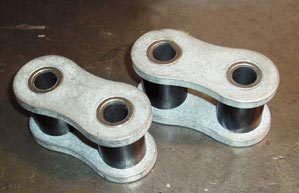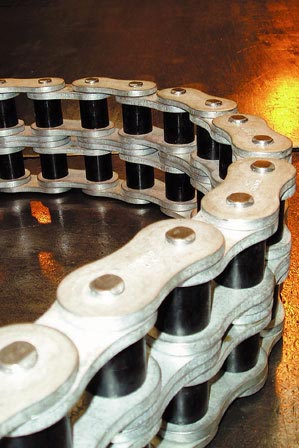Transmission chains
Transmission chains are effectively a series of high precision journal bearings held together by plates. There are 3 concentric components that create each bearing – the pin, the bush and the roller. The pin articulates inside the bush as adjacent links articulate relative to each other on engagement with or disengagement from the sprockets. The load in this bearing is related to the tension in the adjacent chain links. The relative rotation between the bush and roller occurs at the same time and the load on the bearing during this process is related to the contact force with the sprocket teeth.

Standard transmission chains are designed to work at their best with regular re-lubrication, which also acts as protection against corrosion. Large chains in particular are frequently used outdoors and, due to their size, are difficult to put into a housing, such as an oil bath, and maintenance is often overlooked. The result is un-lubricated metal to metal contact inside the chain, which can cause fretting, or galling, resulting in rapid wear or even chain seizure. A range of chains was designed that retained a steel bush to maintain structural integrity of the chain, but incorporated a polymer sleeve between the pin and bush using an iglidur® material developed especially for Renold. A solid polymer roller was chosen to eliminate metal to metal contact at the interfaces with both the bush and sprocket. The use of a solid roller was enabled by using multi-point injection moulding tooling developed by igus® to give the component sufficient strength and roundness. "This product is currently in use worldwide in a wide range of applications."

Chris Lodge
Engineering Manager
Renold Chain